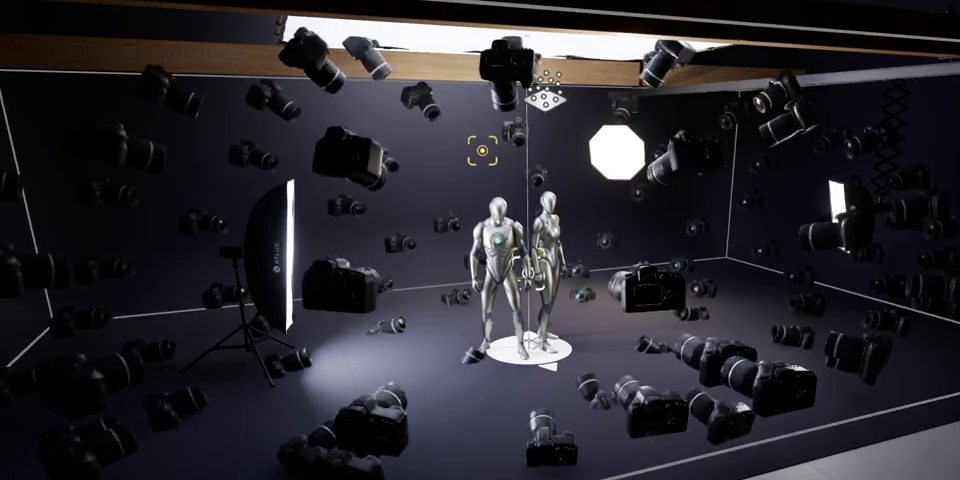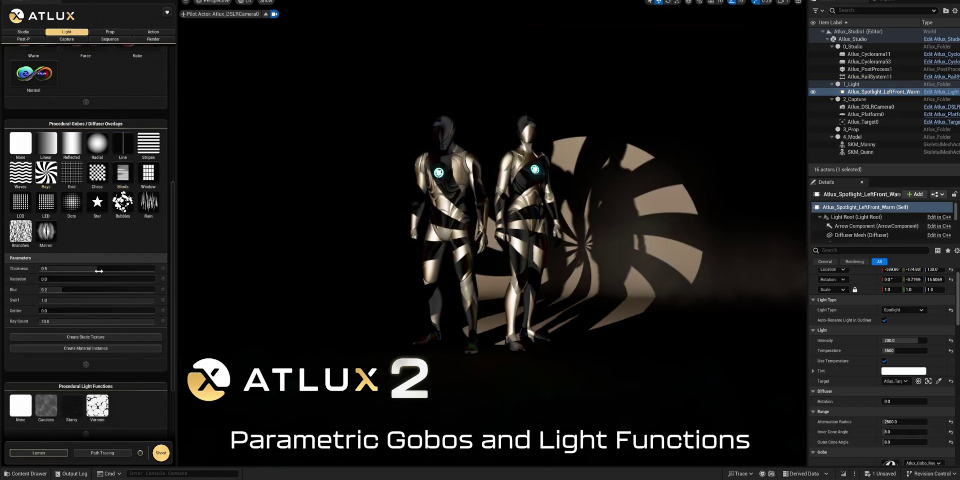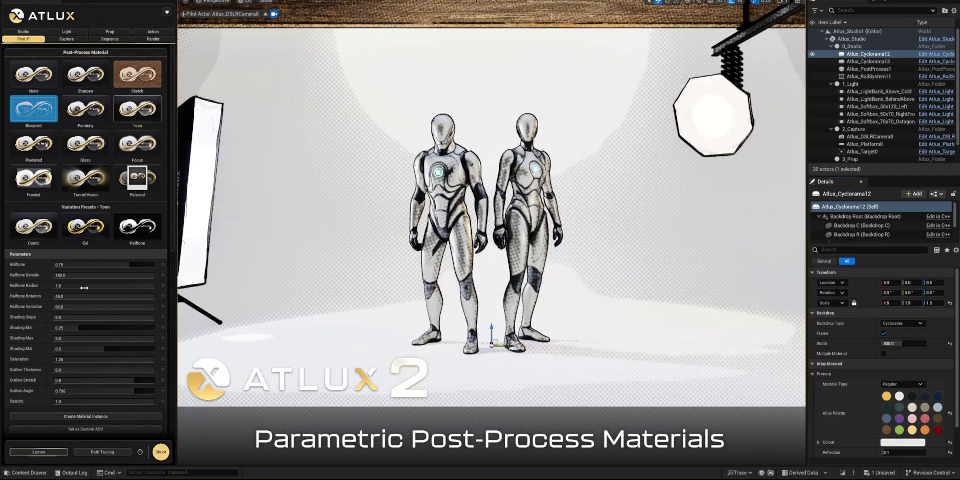Atlux λ 2 puts a virtual 3D scanning studio in Unreal Engine
Vinzi has released Atlux λ 2, a new version of its plugin that recreates a real-world photo studio inside Unreal Engine.
Formerly known as MetaShoot, the add-on streamlines the process of creating photorealistic renders of imported 3D models in the game engine, for visualization work or portfolio material.
Version 2 extends and streamlines its existing functionality, adding new readymade lights, props, animations and post effects.
But more surprisingly, it also makes it possible to set up a virtual 3D scanning studio in Unreal Engine, generating synthetic scan data that can be exported to 3D Gaussian Splatting software.
Recreate a real-world photo studio inside Unreal Engine
Originally released in 2023 under its old name of MetaShoot, Atlux λ streamlines the process of generating photorealistic renders of imported 3D models inside Unreal Engine.
Developed by industrial designer and former Weta Workshop senior 3D modeller Jorge Valle Hurtado, the plugin is intended to provide a workflow for setting up and rendering a scene more familiar to artists without a dedicated games background.
The add-on creates a virtual photo studio inside Unreal Engine, complete with lights, softboxes and cyclorama backgrops, making it possible to recreate real-world studio lighting effects.
A Light Painting system makes it possible to position highlights on models more intuitively.
Suggested use cases range from product and architectural visualization to motion graphics and generating renders of models for portfolio material.

Atlux λ 2: create your own virtual 3D scanning studio inside Unreal Engine
Atlux λ 2 is a major overhaul of the plugin, reorganizing the UI and adding a lot of new capabilities, the most unexpected of which are contained in the new Capture tab.
If the original Atlux λ puts a virtual photo studio inside Unreal Engine, the Capture tab does the same with a 3D scanning studio.
One of its features, the Camera Volume, does so quite literally, distributing virtual DSLR cameras around the target object, to simulate a real-world camera array.
Vinzi pitches it as a way to test and optimize real-world 3D scanning workflows, with users able to adjust camera count, distribution and DSLR properties like aperture, focal length and shutter speed, and see what effect the changes have on the synthetic scan data generated.
That synthetic data can be either a point cloud in PLY format or COLMAP data – including both the point cloud and the camera positions – for use in software like Postshot.
That provides a straightforward way to convert an Unreal Engine scene into 3D Gaussian Splats, which can then be imported into DCC applications that support 3DGS data.

New light types, light controls and procedural gobo system
However, Atlux λ 2 also extends and streamlines the plugin’s original functionality: for lighting and rendering 3D models inside Unreal Engine.
The light assets, previously optimized for Unreal Engine 4’s standalone Ray Tracing system, have been re-optimized for Lumen, which provides the same capabilities in Unreal Engine 5.
The update also adds new Point and Directional lights, new controls for the Spotlight, and four new light presets.
In addition, there is a new system of procedural gobos for projecting patterns of light and color across objects, or acting as diffuser overlays for lightboxes and softboxes.
New readymade studio props, effects and materials
The update also adds a new Prop tab, for adding supporting assets to scenes.
As well as physical props, like podiums on which to place objects, and backdrops like curtains, that includes particle effects, light trails, and fog volumes for effects like god rays.
There is also a new set of readymade materials, including common material types like metals, car paint and fabrics; and a set of decals, including fingerprints and footprints.
For VFX work, there are also readymade color calibration charts and reference balls.
New readymade animations and camera moves
The new Action tab provides access to a range of ‘platforms’ – preset animations for the object being rendered – and camera movements.
As well as the existing product turntables and rig rail camera moves, that now includes floating and breathing animations, and handheld camera motion.

New post process materials for stylizing rendered output
The Post-Process tab provides access to a set of parametric materials applied as post effects.
They can be used to apply a range of non-photorealistic effects to output, ranging from hatching and painterly looks to less usual effects like blueprints, and even LEGO mosaics.
It is also possible to apply LUTs to output: Atlux λ now supports custom LUTs imported on .cube format.
The existing Render tab has also been updated, with artists working in VFX or animation pipelines now able to use custom OCIO (OpenColorIO) settings.
New preset studio set-ups and randomization options
In addition, the update adds six new preset studios, including a garage environment.
The old AI Randomizer, which generated new studios with randomized parameters, has been replaced by a new system, Afflatus, with more controls and the option to randomize only lights.
There are also a number of important bugfixes: in particular, a critical fix for a crash when cancelling a render midway.
Price and system requirements
Atlux λ 2.0 is compatible with Unreal Engine 5.4+ on Windows only. It’s a free update for existing users.
For individual artists, a perpetual license costs $495, up $145 since the previous release. Rental now costs $59.50/month, up $30/month.
For studios with revenue over $5 million/year, a perpetual license now costs $990.50, up $291; rental now costs $109.50/month, up $40/month.
Read a full list of new features in Atlux λ 2.0 on the product’s Discord server
Read more about Atlux λ on the product website
Have your say on this story by following CG Channel on Facebook, Instagram and X (formerly Twitter). As well as being able to comment on stories, followers of our social media accounts can see videos we don’t post on the site itself, including making-ofs for the latest VFX movies, animations, games cinematics and motion graphics projects.
